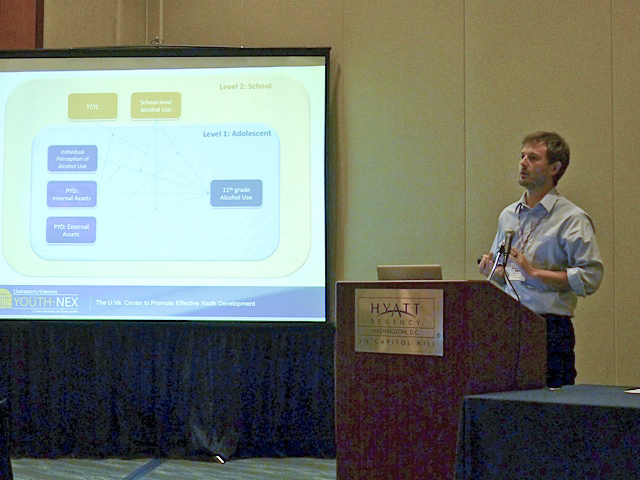Academically, the study of how to bring up healthy young people has traditionally focused on preventing negative outcomes, such as drug and alcohol abuse and bullying. But a team from the University of Virginia's Curry School of Education took a different tack at a recent national conference.
The U.Va. team's project suggestion stemmed from an idea brought up at a Youth-Nex Summit talk earlier this year. The Youth-Nex Center to Promote Effective Youth Development, a cross-university center based at the Curry School, promotes healthy youth development through focused research, training and service. The participants discussed how most data sets relating to youth behavior are very risk-oriented. By contrast, little study exists about positive youth development.
"The absence of bad things happening is not the same as lots of good things happening," said Peter Lovegrove, a postdoctoral research associate at Youth-Nex. He said the team at Youth-Nex has found that promoting positive assets can directly impact substance use and also buffer other risk factors, such as peer norms about smoking, drinking and other substance use.
This was the second year in a row Curry sent a team of graduate students and faculty to the Society for Prevention Research's annual conference in Washington, D.C.
Along with an assortment of panels and workshops, May's conference included a competition, the "Sloboda and Bukowski Cup," in which five teams from academic institutions across the country were challenged to use the same data set to come up with different research projects. Each team gave a 10-minute presentation to an audience and received a score from a panel of judges.
This year's theme was "promoting health through prevention," and the data came from the Adolescent Substance Abuse Prevention Study, a longitudinal study conducted from 2001 to 2005 and backed by the Robert Wood Johnson Foundation.
Lovegrove said Youth-Nex believes in promotion of positive behaviors and prevention of negative behaviors – as well as promotion as prevention. "When kids see friends use drugs, their positive assets buffer that relationship," he said.
One means of promotion comes from after-school programs like Boys & Girls Clubs of America, which provides kids with a structured and supervised environment between the hours of 4 and 6 p.m. – a time when many children are left at home unsupervised.
Angela Henneberger, who earned her Ph.D. from Curry in May and served as team captain, studied contexts in which peers can be positive influences on youth. She called the Boys & Girls Clubs a "perfect example of an organization that really promotes positive development by providing a space for kids to interact safely."
With that in mind, Henneberger said the team aimed to bring something new to the prevention science audience. They took the data set, which concentrated on risk for substance abuse, and pulled out data signifying positive characteristics of individuals. Some of these positive assets included communication skills, positive identity and self-efficacy, a person's belief in their ability to succeed.
Patrick Tolan, who has directed the Youth-Nex center since it began three years ago, said he believes the youth of America are an "untapped resource" in our society and that understanding the roots and relationships of positive development is crucial to shaping young people into healthy adults with strong work ethics.
"We know a lot about how things go wrong with kids, but have limited understanding on how we make things go right," Tolan said.
Although this approach to youth development is gaining traction in academia, Tolan said scholars struggle to secure support for further studies from funders and policymakers because the idea of doing well is more abstract and seems less urgent. For example, potential supporters must be convinced that the absence of a negative result is a real outcome, such as a hypothetical reduction in high school dropout rates from 35 percent to 25 percent over a 10-year period.
"It's harder to get people to fund studies that help us understand how things go well," Tolan said. "It seems like the natural fabric of life – we're trying to say, 'What is in that fabric?'"
Tolan praised the Sloboda Cup competition as a chance for young academics to share their ideas with the pre-eminent scholars in the country.
"What's very important about this conference is it gives early career scientists and students an opportunity to really apply their thinking and come up with creative ways of looking at things."
Although U.Va.'s team did not win the competition, they felt their presentation went well and received positive feedback from the judges and other teams. Henneberger said the team valued the chance to approach existing data from a unique angle.
"A new idea in academia is only as strong as the data that is used to test it," Lovegrove agreed. "It's nice that we get to road test the idea of positive youth development and show that it can be impactful."
Other participating team members included Curry faculty members Valerie Futch, a research assistant at Youth-Nex; Michelle Maier and Ross Larsen, research assistants at the Center for Advanced Study of Teaching and Learning, or CASTL; and Chris Hafen, a research scientist at CASTL.
– by Kate Colwell
Media Contact
Article Information
June 14, 2012
/content/curry-team-poses-new-approach-youth-development-research

